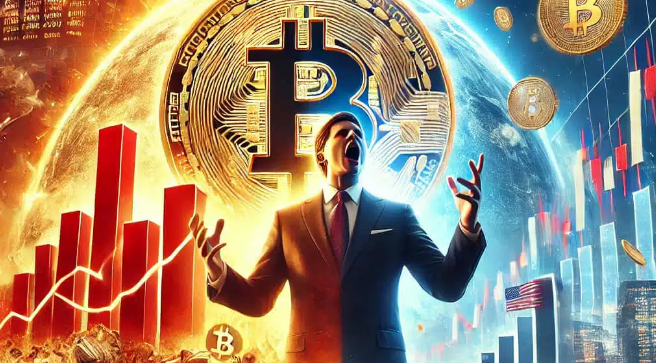As tariff tensions intensify between global economic giants like the United States and China, the traditional financial markets are showing clear signs of strain. From volatile stock indices to currency depreciation, the ripple effects of these trade wars are profound. Amid this uncertainty, however, one asset class is defying expectations—cryptocurrencies are soaring.
Digital assets like Bitcoin, Ethereum, and a host of altcoins have experienced dramatic price surges in recent months, mirroring investor anxiety over traditional markets. But is this just a speculative bubble, or is crypto finally proving its place as a hedge against global economic turmoil?
This article breaks down the connection between tariff tensions and rising crypto prices, why global markets are responding the way they are, and what this means for retail and institutional investors alike.
Global Trade Wars and Financial Market Anxiety
Tariff tensions typically stem from protectionist policies where countries impose duties on imported goods to protect domestic industries. The U.S.-China tariff standoff is one of the most prominent examples, affecting trillions in trade and disrupting global supply chains.
But tariffs don’t just impact trade—they also shake investor confidence, causing:
- Stock market declines
- Currency fluctuations (especially in emerging markets)
- Rising inflationary pressure
- Diminished global growth prospects
When traditional assets start behaving unpredictably, savvy investors begin looking for safe alternatives, and this is where crypto enters the spotlight.
Why Cryptocurrency Is Gaining Traction Amid Tariff Fears
1. Decentralization as a Shield
Cryptocurrencies operate outside the traditional financial system, with no reliance on central banks, political decisions, or trade treaties. This makes them particularly attractive when global financial systems feel compromised or unpredictable.
2. Store of Value Narrative Strengthens
Just like gold, Bitcoin is increasingly seen as “digital gold.” During economic uncertainty caused by tariffs or sanctions, investors turn to Bitcoin for its limited supply and resistance to inflationary pressures.
3. Hedge Against Currency Depreciation
As the Chinese yuan and other emerging market currencies weaken due to trade tensions, crypto becomes a viable hedge. Investors looking to escape depreciating fiat currencies often pour capital into Bitcoin or stablecoins, driving up demand and prices.
Examples of Crypto Surges During Trade Tension Events
U.S.-China Trade War Phases
During specific phases of the trade war—such as the 2019 escalation when tariffs were imposed on $200 billion worth of Chinese goods—Bitcoin prices spiked noticeably. Analysts pointed to Chinese capital flowing into crypto as a way to bypass capital controls and avoid yuan devaluation losses.
2023 Tariff Hikes on Tech Imports
In early 2023, when the U.S. raised tariffs on semiconductors and green energy components from China, tech stocks took a hit. However, Bitcoin and Ethereum rallied by over 15% in a week, fueled by speculation that institutional capital was moving into alternative assets to hedge against the uncertainty.
How Institutional Investors Are Reacting
It’s not just retail investors driving these rallies. Institutional players like hedge funds, asset managers, and family offices are increasingly allocating funds to cryptocurrencies as part of a diversification and risk management strategy.
Increased Allocation to Bitcoin and Ethereum
Many institutions now see Bitcoin as a viable portfolio hedge. Ethereum, with its broad use case in decentralized finance (DeFi) and NFTs, also attracts capital during turbulent macroeconomic periods.
Rising Interest in Stablecoins and Tokenized Assets
Stablecoins like USDC and USDT are gaining favor as low-volatility alternatives to fiat in cross-border transactions. Additionally, tokenized commodities (like gold-backed tokens) are emerging as next-gen safe-haven assets.
Altcoins and Market Sentiment in a Tariff-Driven Rally
While Bitcoin leads the pack, altcoins are often the biggest beneficiaries of increased interest in crypto markets.
Risk Appetite Returns in Waves
After Bitcoin establishes momentum during uncertain times, altcoins like Solana, Chainlink, and Avalanche often ride the wave. Speculators and traders move down the risk curve, looking for high-reward opportunities once confidence builds.
DeFi and Layer-1 Tokens Benefit Most
DeFi ecosystems often see spikes in total value locked (TVL) as investors move into yield-generating protocols. Similarly, Layer-1 blockchains that support smart contracts tend to rise in tandem with growing demand for decentralized alternatives.
Are Tariff Tensions Creating a New Crypto Investment Cycle?
While previous bull runs were driven by speculation, halving cycles, and tech hype, the current surge in crypto prices appears tied closely to macro-level economic factors—specifically, reactions to global trade instability.
This shift in narrative is important. It signals that crypto is maturing into an asset class that responds to real-world events, not just internal ecosystem developments.
If global trade remains contentious, we could be witnessing the beginning of a new macro-driven crypto bull cycle—one fueled not by hype, but by demand for alternative financial infrastructure.
Risks and Considerations for Crypto Investors During Tariff Conflicts
While the price rallies may seem promising, investors must still proceed with caution. Crypto remains a highly volatile and speculative space, even when it behaves as a macro hedge.
1. Short-Term Volatility Can Be Severe
Headlines around tariffs, sanctions, or political negotiations can cause whiplash-style reversals in price. Proper risk management is crucial.
2. Regulatory Uncertainty
Governments may respond to increased crypto usage with tightened regulation, especially if they perceive capital flight or financial instability.
3. Don’t Chase the Hype
Entering the market on euphoric highs often leads to regret. Focus on long-term strategy and diversification, not impulsive trading based on short-term news cycles.
Strategies to Capitalize on the Crypto-Tariff Correlation
If you believe global trade tensions will persist, here are ways to position your crypto portfolio:
- Hold core assets like Bitcoin and Ethereum for long-term value retention.
- Use stablecoins during volatile market conditions to protect capital.
- Explore DeFi opportunities for yield generation during sideways markets.
- Watch global news for tariff updates and economic reports—crypto prices often lead or lag these macro signals.
Conclusion: Crypto’s Role in a Trade-Tense Global Economy
The surge in crypto prices amidst global tariff tensions is no coincidence. It represents a broader shift in how investors perceive risk, store value, and navigate economic uncertainty.
Cryptocurrency is no longer a fringe asset. It’s becoming a strategic financial instrument, especially when traditional markets falter under geopolitical pressures.
As the global economic order evolves, and trade disputes become the norm rather than the exception, crypto’s position will only grow stronger. For investors willing to understand and embrace this new paradigm, the opportunities are vast—but so are the responsibilities.
Want this tailored for your blog, company newsletter, or investor report? I can also generate SEO metadata, featured image suggestions, and related keyword lists for search visibility. Just let me know!

Also Read :
